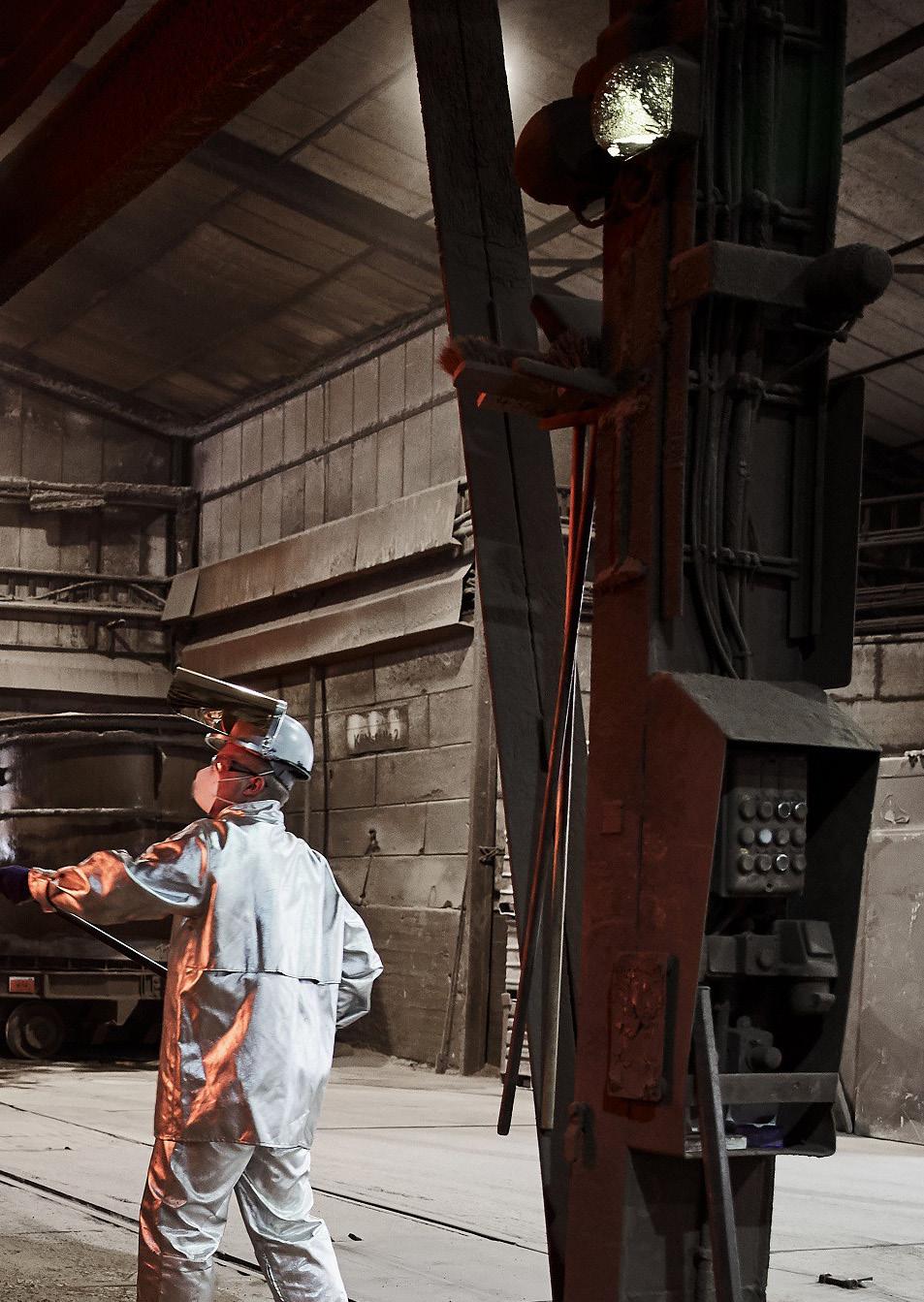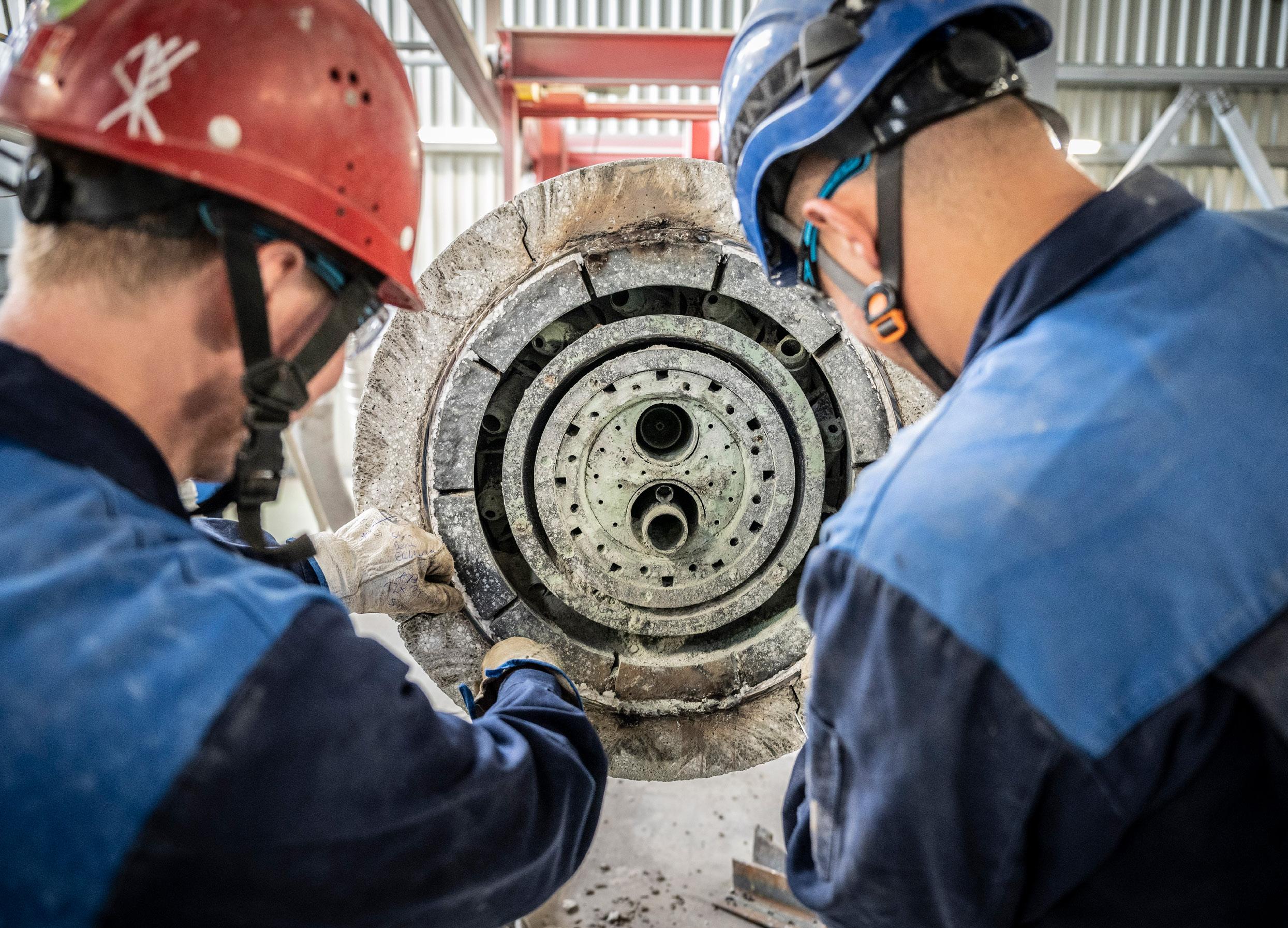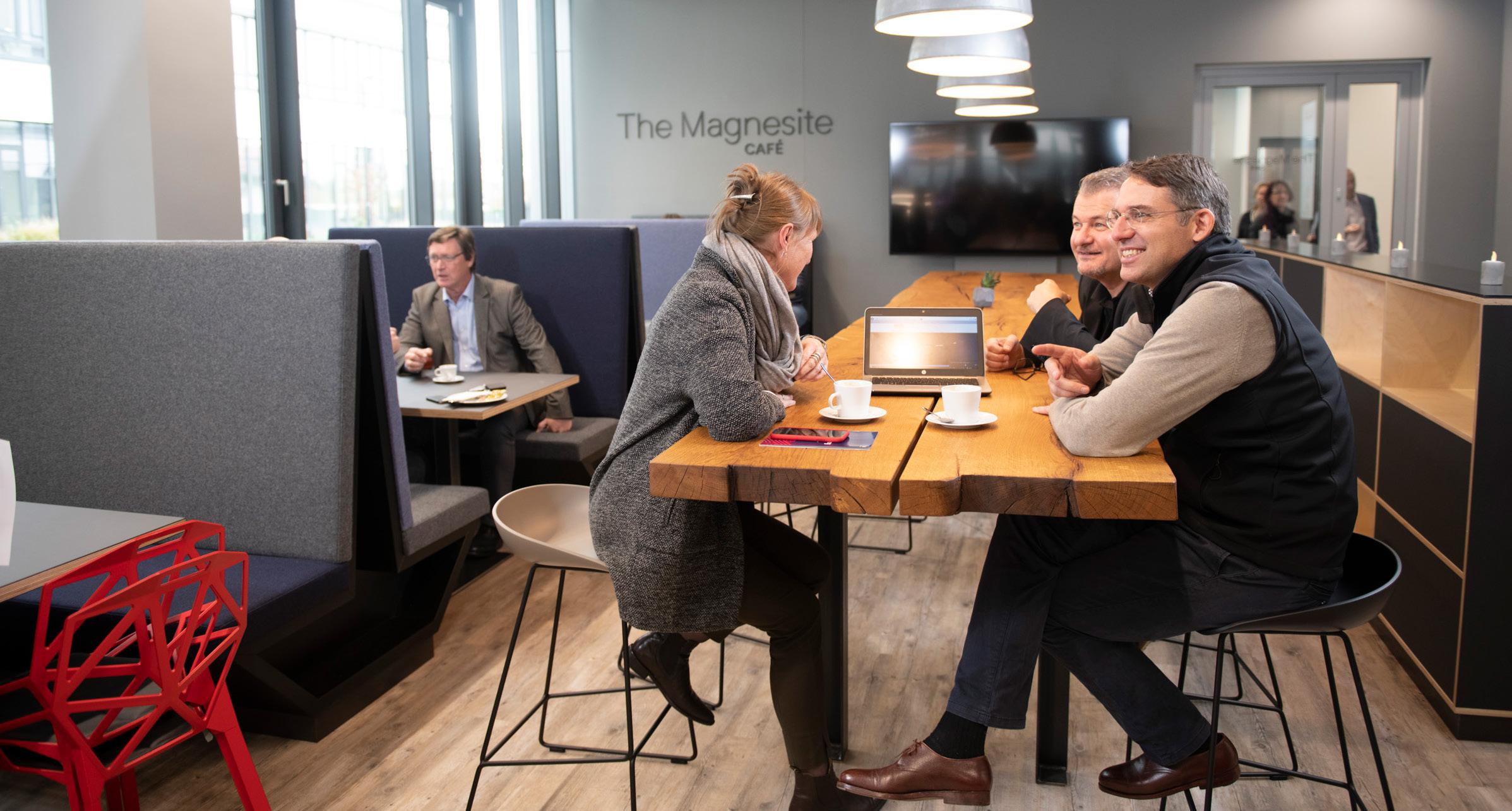




PROJECT PARTNER



Marc Jaegers, Global Logistics Technology and Innovation Manager and Daniel Prutti, Head of Global Logistics, Planning and Procurement at RHI Magnesita share insights into the company’s journey to overhaul its global logistics operations.
he company strives to leverage its leadership in terms of revenue, scale, product portfolio and diversified geographic presence to target strategically those countries and regions benefitting from more dynamic economic growth prospects.
With a vertically integrated value chain, from raw materials to refractory products and full performance-based solutions, RHI Magnesita serves customers around the world, with around 16,000 employees in 47 main production sites, 8 recycling facilities and more than 70 sales offices.
This vertically integrated value chain not only protects RHI Magnesita from external disruptions – it
provides a resilient foundation for innovation. In recent years RHI Magnesita has embraced a journey of comprehensive global logistics transformation – revolutionising its culture, strategic partnerships, supply chain, procurement, technology and regionalised approach to globalised operations in the process.
Here to walk us through the transformation journey are Marc Jaegers, Global Logistics Technology and Innovation Manager and Daniel Prutti, Head of Global Logistics, Planning and Procurement at RHI Magnesita.
Marc and Daniel set the scene for the company’s transformative journey by rewinding to 2017, when RHI AG merged with Magnesita, based in Brazil. The combination

of two world-leading refractory companies catalysed a need for a comprehensive global logistics transformation at the newly formed RHI Magnesita.
Daniel has been with RHI AG and RHI Magnesita for a total of 12 years, and in the last two he has headed its global logistics team – which started with just three people, but has now upscaled its capabilities tremendously by appointing internal talents to key roles as well as hiring external ocean trade experts. This growth reflects the company’s
burgeoning focus and attention on global logistics. In April 2024, this global logistics team merged with the procurement department –bringing planning, logistics, supply chain and procurement under one banner.
Marc joined RHI Magnesita in 2019 and his background is in logistics, technology and consulting. Marc thrives on creating road maps to bring value to a company, and he saw a tremendous opportunity for comprehensive change – driven by technology, expertise and strategic

overhaul – when he joined the business.
So what were the values underpinning the strategic roadmap for RHI Magnesita’s transformative journey?
The process began with a period of self-reflection and mindset change, according to Daniel.
“Our first conclusion was that, as a world-leading refractory company, our success depends on global logistics – but we are not a freight forwarding company,” says Daniel. “This realisation led us to identify a need for choice and value. Therefore, our first objective was strategic alliances: finding the right partners who could work with us long term.
“Closely related to this was the second objective, where we began the process of overhauling our partner performance analysis and management.
“The third objective within the global logistics transformation hinged on process excellence. Because many of our competitors are regional or even local players, we recognised this gave them a degree of agility based on proximity as we initiated the self-reflection stage of the transformation. We wanted to match this agility and responsiveness by developing our process excellence and joining this endeavour to the first objective of wielding strategic partners. As a vertically integrated company, one of our key strengths is we are now able to orchestrate globally but execute regionally and locally.
“The final piece of the puzzle in those early days, when we prepared to embark on our transformation journey, was the establishment of a strong relationship with asset owners. If you look at the ocean market these days, the asset owners (ocean lines) have an incredible command of the freight industry. If you consider the dozens of freight forwarders offering freight services, in reality, they are all beholden to a small handful of major ocean asset owners.
“WE KNEW WE NEEDED TO HAVE THE RIGHT TECHNOLOGY IN PLACE FOR US TO SUPPORT ALL THE CHANGES THAT WE WANTED TO ENACT”Marc Jaegers, Global Logistics Technology & Innovation Manager
“Once we realised this, we changed our approach radically and sought to deal with the ocean lines directly, as much as possible, to enhance our freight network and bring in new concepts to transform our operations and thrive as a business. In 2021, only 5% of our business was contracted with ocean asset owners. Now, in 2024, that number is closer to 50%.”
Once these priorities had been identified, RHI Magnesita turned its attention to the technology and strategies which would enable progress towards them. However, as Marc notes, while there were IT components to the transformation – it was not a purely IT project. Instead, it had to be a businessdriven rather than an IT-driven initiative.
“We knew we needed to have the right technology in place for us to support all the changes that we wanted to enact,” says Marc. “But the momentum for the project stemmed from the business organisation and not
the IT organisation alone. While we of course aligned closely with the IT department along the way, we built a comprehensive change management support mechanism around the project, drawn from stakeholders in multiple teams across the company, to enable the deep, meaningful transformation and the new ways of working we were striving towards.”
How did Marc, Daniel and the global logistics team tie the transformation into broader corporate strategies and start bringing in the new technologies to enable it?
“When we started this project, we considered how can we ensure that we support the company in various areas but also align the transformation with broader corporate strategies,” explains Marc. “One of the drivers at the corporate level was we wanted to avoid what we call ‘value leakage’ from the business.
“One example is in transportation management. If you have limited

control over your transportation management, you can end up spending money where you don't want to spend money, for instance, on demurrage costs.
“As such we had to connect the global logistics transformation project to the broader company strategy for facilitating better cost control measures.
“Another contextual factor for the project was the company’s concurrent mindset shift to endto-end value chain thinking, with a strong emphasis on customer centricity.
core component of the global logistics transformation. We have a very complex and expansive supply chain because we move a large part of our goods around the world. But they're ultimately managed and distributed locally. We wanted to ensure that by having the right technology and collaboration platform in place, we could facilitate closer interactions between our global and regional teams. In the process, we have forged a deeper tactical and operational connection between all levels of the company: using the same data on the same platform, seamlessly.”
The need to deploy a new enterprise resource planning (ERP) system, which can be a major disruptive experience for companies, added extra impetus to the global logistics transformation, shares Daniel. However, the success of the transformation project placed RHI Magnesita in a strong position to begin its ERP transition this year, he notes.
“Lastly, the broader corporate strategy for shifting to a more regional and local focus was a
“Most traditional ERP setups are too complex to drive value and benefits,” argues Daniel. “In conjunction, as with many other companies relying on SAP R/3, we knew change was imminent with the transition to S/4HANA. In light of all this, we wanted to mitigate the risks of transformation to a new ERP as much as possible.
“WE KNOW THAT INTEGRATED SYSTEMS OFFER ADVANTAGES, BUT OUR COMPANY CLEARLY SAID WE ARE NOT AFRAID OF BRINGING IN THE BEST SYSTEMS IN EACH FIELD”Daniel Prutti, VP - Head of Global Logistics, Planning and Procurement
“We asked ourselves how we could offset the risk of such a big programme, and it became clear that we needed to deploy the changes related to our transportation, foreign trade,
logistics transformation and technology up-scaling first.”
Elaborating on the role of technology upscaling within the transformation journey at RHI Magnesita, Daniel

“WHEN WE CONSIDERED WHAT WOULD OFFER US THE BEST OVERALL VALUE CASE FROM A TECHNOLOGY MATURITY LEVEL, ORACLE OFFERED THE BEST SOLUTION”
highlights the need to balance developing integrated systems while recognising where it would be best to outsource technological dynamics or software solutions with strategic partnerships.
“We know that integrated systems offer advantages,” begins Daniel. “But our company clearly said we are not afraid of bringing in the
best systems in each field. With the current state of digitalisation we see today, there are very powerful software solutions and integrator or orchestrator tools available on the market. Also, there comes a point where you need to recognise your strengths as a company and bring in external experts or products to support your operations – so you can focus on what you do best. We
Unlock Growth Potential with Oracle Transportation Management!
Oracle was thrilled to collaborate with RHI Magnesita on their transportation initiative. Together, we're rede�ning logistics processes and delivering a �exible, agile global transport operation.
Customers demand solutions that evolve with their dynamic supply chain needs. That's why we're investing in AI, Machine Learning, Sustainability and Tactical Modeling capabilities. Join us on this transformative journey!
Ready to revolutionise your transportation strategy? Click below to learn more and partner with Oracle today!
Learn more


are not a freight company or an IT business, for instance – so therefore we need to find the best solutions to meet our business ambitions. We also realise that as we have digitalised our company, upscaling our own integrated systems and technology solutions, we have become even more attractive as prospective partners in the process. In this way, we can drive down the total cost of ownership because our processes and technology offer mutual benefits of efficiency and effectiveness to both us and our partners.”
Marc weighs in here to emphasise the importance of RHI Magnesita’s approach to partner selection and how the company envisions its technology solutions as a platform for the future.
“When we started the selection process, we did not want to go through a traditional paper-based request for quote (RFQ) process,” explains Marc. “For instance when we sought a new transportation management system (TMS), we spoke to a vast number of relevant vendors, created a shortlist and called a meet and greet session. Here we explained our needs and our guests had the opportunity to explain their solutions and offerings in response. Compared to the paper-based approach, which can be cumbersome, we
quickly identified a shortlist of three leading companies we felt could meet our requirements. Then, we invited all of them to a two-day workshop to meet representatives from the functional areas of RHI Magnesita, who were stakeholders in the new TMS. Following this, the various stakeholders were invited to contribute to the final selection by ranking the tools from their perspective. After embarking on this comprehensive selection process, we concluded that Oracle offered the best overall value for the company to become our new TMS provider.
“Our assessment at the time was that, first of all, Oracle was very clear about what they could offer us from day one. Second, we also felt that Oracle had a deep understanding of what our company needed. Lastly, when we considered what would offer us the best overall value case from a technology maturity level, Oracle offered the best solution.”
Daniel adds that Oracle’s focus on best practices related to cloud technology and the support from their knowledgeable sales representatives were clear differentiators which set them apart from the other candidates in the selection process. But Daniel also stresses it took working with the right implementation partner to make deploying the new TMS system from Oracle an even greater success. This
is where Tata Consultancy Services (TCS) stepped in to assist with the process.
“Our initial implementation partner in the TMS project was very strong and created a comprehensive solution for land freight, but the journey towards a scalable ocean freight product was taking too long and at certain key moments we lacked the internal knowledge to implement effectively,” says Daniel. “We needed fresh wind in our sails. We took our problem statement to the market and asked a simple question: how would you help us solve this situation?
“After engaging with several vendors, the speed and the innovative thinking TCS brought to the table was outstanding. They came in with the best resources from a range of backgrounds and disciplines from all over the world to help us. And it wasn’t just the speed of TCS that was remarkable, but also the accountability they took from day one which was really impressive. They analysed the problems we presented to them, came back with solution proposals and once we decided on a course of action, they went after it 100%. They have forged a place as one of our key partners for digitalisation.”
Speaking about the partnership from the TCS side, Brian Popoff, Managing Partner, Supply Chain
Consulting, adds “TCS brought both functional knowledge of ocean transportation and the technical expertise of OTM to RHI Magnesita to create a modular and scalable global template. This effort was complemented by RHI Magnesita’s in-depth business and SAP knowledge coupled with their very collaborative and transparent way of working on complex programmes such as this.”
Turning to the concept of technology as a platform for the future, Marc continues with the example of RHI Magnesita’s strategic partnership with Oracle as their TMS solution provider.
“From the outset, we knew we wanted to develop long-term, multiyear partnerships as part of our global logistics transformation and for the company’s benefit more broadly,” explains Marc. “We saw value in developing our technology solutions as a platform for the future, a foundation we could build on in the years ahead and take in multiple directions if we needed to. For instance, we see our TMS as a core component of our management activities. We had already connected additional functionality elements to our TMS such as real-time visibility, diversion tracking and specific marine traffic monitoring tools. But we know that in the future we might want to connect more functionality dynamics into it, such
as 4PL, machine learning and AI. Any solutions we bring in have to integrate backwards with our ERP environment as well. Or, if we place certain aspects of logistics under different management, we want to be able to connect the systems seamlessly. This is why we conceptualise our technology as a platform, not a standalone tool, so we can evolve and adapt in the years ahead.”
Deploying technology solutions as a platform for the future requires holistic support from the right partners, Daniel reiterates.
“We have learned throughout this transformation journey that we don't need to do this all by ourselves,” says Daniel. “We place trust in external partnerships and alliances as we have seen the tremendous

Our multi-model transportation management solutions can help shippers manage logistics processes reliably and efficiently
TCS provides tailored solutions for all transportation modes that provide seamless execution and visibility of shipments, globally. These solutions provide optimal planning and utilisation of freight volumes and capacity that can result in substantial cost savings. Our in-depth knowledge of logistics processes, expertise in Oracle Transportation Management®, and years of transportation domain experience are key factors for an innovative and cost-optimising solution
benefits of these co-development arrangements firsthand since 2020. If you look externally, there are helping hands available to support you from companies that have already been through what you’re looking to achieve. We have grown considerably in our approach to partnerships and alliances by putting smart architecture, consistent analysis and robust performance management mechanisms in place.”
Here Marc emphasises that the transformation programme underway at RHI Magnesita is a multi-year, long-term project.
“While we have a clear vision of where we are going, we must also be careful not to try and realise it prematurely because the company might not be ready for it,” says Marc. “It is a process of reaching milestones and progressing along the journey intelligently, reflectively and intentionally.”
As with any long-term project though, broader company buy-in is crucial. Daniel and Marc agree that the organisational support and company culture at RHI Magnesita have been essential to the success of the global logistics transformation project.

shift behaviour, before looking at processes and then finally technology. In the case of the transformation project at RHI Magnesita, the preliminary behavioural change goal was to create a company culture driven by “customer obsession,” as Marc puts it. But without the organisational support behind him, Daniel and their team – it would not have been possible.
For Daniel, there were four main ways the organisational structure and company culture supported their mission.
When it comes to change management, Marc insists that the first step of the journey is to
“First, we started the transformation with the global process owner model, but more importantly in 2021,

we spent extensive time clarifying people’s roles within the process,” says Daniel. “Even though it’s super bureaucratic, it is fundamental to document responsibilities and accountabilities.
“Second, we enshrine diversity within our company culture at RHI Magnesita because it fosters vibrant innovation. In our global logistics teams, 40% are female leaders and we have 10 nationalities represented in a team of less than 20 colleagues. Third, we secured companywide support by bringing in experienced change managers from within the business, with a track record for successful projects, to elevate the endeavour and support us almost as ‘transformation cheerleaders.’
“Lastly, in a large global company of more than 16,000 employees, we could not have done this without the patience and support from the very top. Our executive team trusted us to guide the company through this transformation and we are incredibly grateful to them, and our team, for making it possible.”
So what have been the tangible outcomes of the global logistics transformation at RHI Magnesita?
“If you look at the business case, we have over-achieved on our savings commitment,” says Daniel. “Our freight rates have returned to relatively normal levels, within the post-COVID-19 context and with market adjustments in mind. We have also made efficiency gains especially when it comes to how we deal with our customers. To share a demonstrative example here, when the Ever Given blocked the Suez Canal in 2021, it took us two or three weeks to assess the situation and relay the projected impact to our customers. Compare this to the Houthi attacks on commercial vessels in the Red Sea at the end of 2023, we were able to share impact assessments with our customers in 24 hours and share further insights and predictions within three working days.
“Another huge victory for us tied to the global logistics transformation project is we opened a container
“WE STILL HAVE A WAY TO GO, BUT OUR GOAL IS TO PROVIDE AUTOMATIC INSIGHTS WHILE ALSO PROVIDING OUR CUSTOMERS WITH SELF-SERVICE”
depot with a rail connection in 2023. In my early years at the company, this would have been inconceivable. But now we believe in such ambitious goals as a company – the sky is the limit.”
Looking ahead to the future and the next steps of the transformation journey, Marc adds that several new initiatives are on the horizon in the next few years.
“We will continue to strive for better organisation of our logistics networks with even more control and visibility with technology,” says Marc. “In the near term, our roadmap focuses more directly on customers. We are looking to enhance our engagement with them with more direct notifications, so we can proactively inform them as early as possible to avoid surprises. We are exploring ways to tailor our services to the



customer depending on where they sit in the value chain. Lastly, as a company, we want to make meaningful contributions in terms of our sustainability. As such we are working to reduce our carbon footprint but also designing carbonneutral services for our customers, with detailed insights into emissions so they can have a better overall experience with us.”
For Daniel, a major aspiration is to build a self-service model for RHI Magnesita’s customers.
“We still have a way to go, but our goal is to provide automatic insights while also providing our customers with self-service,” says Daniel. “As it stands, we have built the foundation so our customer service representatives can provide these insights. One thing we must consider as a business is we make
deals and enter negotiations onsite, not via auctions or online tools. In a sense, we still operate commercially in a more traditional environment. But we still want to incorporate digital processes and technology where we can and ultimately work towards self-service.
“Part of this will be to wield data even better and we’re doing a lot of testing on this front. At the moment the insights are focused towards our internal commercial management teams, which they then take to the customer. The next step will be to replicate the immediate access to information we have in our private lives and make that the status quo for our customers, so they have the best experience possible.”
For further information about RHI Magnesita, visit rhimagnesita.com

Daniel and Marc laud the collaboration, courage, creativity and conviction it took to embark on the global logistics transformation. They both express deep gratitude to the executives, senior leaders and members of the multiple teams involved at the company for delivering such an expansive transformation project.
“I am particularly proud of Marc, he lived the transformation and channelled the customer obsession as a project manager and he never lost sight of the final destination,” says Daniel.
Marc responds in kind, celebrating Daniel’s management and leadership style. “Under Daniel’s leadership, the global logistics team has been able to thrive because he offers the luxury of space, trust and time to guide the journey forward. Our executive team and Daniel as the Head of the Global Logistics Team have been willing to invest the time and resources to make such an enormous and ambitious project possible. It has been key to the success of the transformation.”
Daniel likes to share a quote from Aristotle Onassis: “We must free ourselves of the hope that the sea will ever rest. We must learn to sail in high winds.”
For Daniel, this sentiment is particularly pertinent to the maritime industry and global logistics more broadly.
“The disruptions during COVID-19, for instance, were crazy,” says Daniel. “Costs went up as a result of a spike in demand after a huge drop and operations had to change drastically. But from my perspective, you cannot let yourself become nervous, panicked or overwhelmed.
“Throughout our transformation, I have been tremendously proud of our team and how they remained calm during the ups and downs, creating the psychological conditions needed to navigate the journey. We have created a cultural environment where we understand that failure is not final, and this mindset is essential when you embark on transformation.”
Marc enjoys staying in touch with the industry by educating and immersing himself in the latest innovations.
“I like to read up on new developments and consider how they might inform our roadmaps for the future,” says Marc. “I dive into a range of topics, like machine learning, artificial intelligence and virtual reality. I explore these subjects through trade magazines, conferences and discussions with colleagues to share information in diverse fields. It is particularly fascinating to see where other companies and your peers are in their journey, while seeking to understand their line of thinking. I think of it as a cross-pollination of ideas.”
